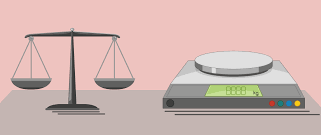Measuring Mass is equivalent to determining the quantity of matter in a substance. Matter is anything that occupies space.
The mass of an object depends on it’s size and the number of particles it holds. The SI unit of mass is the Kilogram (Kg).
A kilogram is the mass of a piece of platinum-iridium metal. It is kept at Sevres, near Paris, France. This is located at the International Office of Weights and Measurements. That piece of metal kept in France is the standard. It is used to measure all masses in the world with the kilogram unit.
though kilogram is the SI unit, the most common unit of measuring mass is the gram.
The following table shows sub-units of gram and kilogram
| Prefix | number of grams (g) |
|---|---|
| Kilogram (Kg) | 1000 g |
| Hectogram (Hg) | 100 g |
| Decagram (Dg) | 10 g |
| decigram (dg) | (1/10) g |
| centigram (cg) | (1/100) g |
| milligram (mg) | (1/1000) g |
| microgram (µg) | (1/1000,000) g |
| nanogram (ng) | (1/100,000,000) g |
| picogram (pg) | (1/1000,000,000,000) g |
1000kg = 1 tonne
Other units used to measure mass includes:
- 1 pound (lb) = 0.4536 kg)
- 1 ounce(oz) = 0.02835kg
Objects experience different weights depending on the gravitational pull of a place. But, the mass of an object remains constant. This is because the number of particles in an object does not change with a change of location.
Instruments in measuring mass
1.Platform balance

2. Electronic balance
The object whose mass is to be measured is placed on the pan. Its weight triggers the electronic circuit to develop a current. This current displays the mass on the digital display. It is a very accurate instrument and is useful in laboratories especially small masses.

3. Beam balance
Beam balance using the principles of moments. The object whose mass is to be measured is balanced against a known standard mass on as equal arm lever. The beam balances when the mass of the object is equal to the standard mass.

4. Table balance
works under principles of moments

5. Spring balances
uses laws of gravitational pull

6. postal balance

7. Roman Steelyard Balance

Exercise
convert the following as instructed
- 1500 tonnes to kg
- 200000000000 mg into Kg.
- 256 g into tonnes
- 0.000000000000000000 567 tonne into pg
- 12.43 g into mg
Problems involving mass
- Sheila went to the grocery store and bought a 3 watermelons that weighed 4.4 kilograms and a bunch of bananas that weighed 750 grams. She also bought a bottle of juice that contained 1.2 liters.
a) Convert the weight of the watermelon from kilograms to grams.
b) If Sarah bought 3 bottles of juice, how many grams of juice did she buy in total if density of juice is 1.25g cm-3?
c) If each banana weighs 125 grams, how many bananas did Sarah buy?
Related Topics
- Physical Quantities
- Measuring Area: Precise discussion
- Length
- Reading a meter rule
- Measuring with a meter rule
- Area
- Area of irregularly shaped surfaces
- Volume
- Volume of regularly shaped objects
- Measuring volume of liquids
- Volume of irregular solids
- Measuring Mass
- Density
- Densities of some substances
- Questions on Measurements
- Mathematics


Leave a Reply